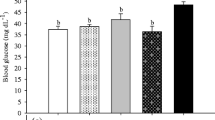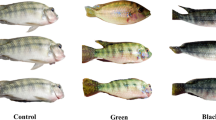Abstract
The trade of aquarium organisms is growing worldwide. This market depends on a continuous supply of healthy and colorful aquatic animals, but this sector has few initiatives. However, in the last decade, there has been a growing interest in researching captive breeding of these animals, aiming to develop a more sustainable aquarium hobby. Larviculture is an important phase in the cultivation process because the larvae are more sensitive to stress and variations in the bulk of variables, such as temperature, salinity, nutritional management, light intensity and spectrum, and environmental background colors. Because background color could be a promoter variable of proper welfare, we tested whether it affects the endocrine response of tomato clownfish Amphiprion frenatus larvae to an acute stress challenge. We show that background color influences the endocrine stress axis responsiveness in tomato clownfish. When fish were subjected to a standard acute stressor of 61 days after hatching, only fish adapted to white walls increased the whole-body cortisol levels. From the results presented herein, we recommend that white tanks be avoided for A. frenatus larviculture. Both, the less stress level and the good welfare condition of larvae reared in colored tanks may have robust, practical applications since almost all clownfish in the ornamental aquarium trade come from captive breeding.


Similar content being viewed by others
Data availability
The data that support the findings of this study are available from the corresponding author upon reasonable request.
References
Abe HA, Dias JAR, Reis RGA, Sousa NC, Ramos FM, Fujimoto RY (2016) Manejo alimentar e densidade de estocagem na larvicultura do peixe ornamental amazônico Heros severus. Bol Inst Pesca 42(3):514–522. https://doi.org/10.20950/1678-2305.2016v42n3p514
Abreu MS, Koakoski G, Ferreira D, Oliveira TA, Rosa JGS, Gusso D, Giacomini ACV, Piato AL, Barcellos LJG (2014) Diazepam and fluoxetine decrease the stress response in zebrafish. PLoSONE 9(7):e103232. https://doi.org/10.1371/journal.pone.0103232
Abreu MS, Giacomini ACVV, Genario R, Santos BE, Marcon L, Demin KA, Kalueff AV (2020) The impact of housing environment color on zebrafish (Danio rerio) anxiety-like behavioral and physiological (cortisol) responses. Gen Comp Endocrinol 294:113499. https://doi.org/10.1016/j.ygcen.2020.113499
Balamurugan J, Kumar TTA, Prakash S, Meenakumari B, Balasundaram C, Harikrishnan R (2016) Clove extract: a potential source for stress free transport of fish. Aquaculture 454(1):171–175. https://doi.org/10.1016/j.aquaculture.2015.12.020
Balm PHM, Hovens MLM, Wendelaar Bonga SE (1995) Endorphin and MSH in concert form the corticotropic principle release by tilapia (Oreochromis mossambicus: Teleostei) melanotropes. Peptides 16:463–469. https://doi.org/10.1016/0196-9781(94)00204-J
Barcellos LJG, Kreutz LC, Quevedo RM, Rosa JGS, Koakoski G, Centenaro L, Pottker E (2009) Influence of color background and shelter availability on jundiá (Rhamdia quelen) stress response. Aquaculture 288:51–56. https://doi.org/10.1016/j.aquaculture.2008.11.002
Barton BA (2002) Stress in fishes: a diversity of responses with particular reference to changes in circulating corticosteroids. Integr Comp Biol 42:517–525. https://doi.org/10.1093/icb/42.3.517
Bayrami A, Noverian HA, Sharif EA (2017) Effects of background colour on growth indices and stress of young sterlet (Acipenser ruthenus) in a closed circulated system. Aquacult Res 48:2004–2011. https://doi.org/10.1111/are.13033
Biondo MV, Burki RP (2020) A systematic review of the ornamental fish trade with emphasis on coral reef fishes—an impossible task. Animals 10(11):2014. https://doi.org/10.3390/ani10112014
Deal CK, Volkoff H (2020) The role of the thyroid axis in fish front. Endocrinol 11:596585. https://doi.org/10.3389/fendo.2020.596585
Díaz-Jiménez L, Hernández-Vergara MP, Pérez-Rostro CI, Olvera-Novoa MÁ (2021) The effect of two carotenoid sources, background colour and light spectrum on the body pigmentation of the clownfish Amphiprion ocellaris. Aquacult Res 52(7):3052–3061. https://doi.org/10.1111/are.15149
Doolan BJ, Allan GL, Booth MA, Jones PL (2008) Effects of cage netting colour and density on the skin pigmentation and stress response of Australian snapper Pagrus auratus (Bloch & Schneider, 1801). Aquacult Res 39:1360–1368. https://doi.org/10.1111/j.1365-2109.2008.02003.x
Holt GJ (2003) Research on culturing the early life stages of marine ornamental fish. Iowa State Press, Ames, Iowa
Huising MO, Metz JR, van Schooten C, Taverne-Thiele AJ, Hermsen T, Verburg-van Kemenade BML, Flik G (2004) Structural characterization of a cyprinid (Cyprinus carpio L.) CRH, CRH-BP and CRH-R1, and the role of these proteins in the acute stress response. J Molecul Endocrinol 32:627–648. https://doi.org/10.1677/jme.0.0320627
Iwata E, Mikami K, Manbo J, Moriya-Ito K, Sasaki H (2012) Social interaction influences blood cortisol values and brain aromatase genes in the protandrous false clown anemonefish, Amphiprion ocellaris. Zool Sci 29:849–855. https://doi.org/10.2108/zsj.29.849
Lamers AE, Flik G, Atsma W, Wendelaar-Bonga SE (1992) A role for di-acetyl α-melanocyte stimulating hormone in the control of cortisol release in the teleost Oreochromis mossambicus. J Endocrinol 135:285–292. https://doi.org/10.1677/joe.0.1350285
Maia CM, Alves NPC, Tatemoto P (2021) Juvenile Nile tilapia fish avoid red shelters. J Appl Anim Welf Sci 24(1):98–106. https://doi.org/10.1080/10888705.2020.1848567
Maia CM, Volpato GL (2013) Environmental light color affects the stress response of Nile tilapia. Zoology 116(1):64–66. https://doi.org/10.1590/S0100-879X2001000800011
Mapunda J, Mtolera MSP, Yahya SAS, Ngo VM, Golan M, Nguyen VM (2021) Effect of tank colour on growth, survival, stress level, digestive enzymatic activities and body composition of snubnose pompano (Trachinotus blochii Lacépède) larvae. Aquacult Res 52(12):6244–6255. https://doi.org/10.1111/are.15487
Martin-Robichaud DJ, Peterson RH (1998) Effects of light intensity tank colour and photoperiod on swimbladder inflation success in larval striped bass, Morone saxatilis (Walbaum). Aquacult Res 29:539–547. https://doi.org/10.1046/j.1365-2109.1998.00234.x
Mills SC, Mourier J, Galzin R (2010) Plasma cortisol and 11-ketotestosterone enzyme immunoassay (EIA) kit validation for three fish species: the orange clownfish Amphiprion percula, the orangefin anemonefish Amphiprion chrysopterus and the blacktip reef hark Carcharhinus melanopterus. J Fish Biol 77:769–777. https://doi.org/10.1111/j.1095-8649.2010.02693.x
Mills SC, Beldade R, Henry L, Laverty D, Nedelec SL, Simpson SD, Radford AN (2020) Hormonal and behavioural effects of motorboat noise on wild coral reef fish. Env Poll 262:114250. https://doi.org/10.1016/j.envpol.2020.114250
Miyai CA, Sanches FHC, Costa TM, Barreto RE (2020) Intruder traits modulate aggressive behavior of territory owners. Sci Rep 10:12050. https://doi.org/10.1038/s41598-020-68513-1
Morshedi V, Pradhoshini KP, Tangestani N, Ghasemi A, Sotoudeh E, Gamoori R, Musthafa MS (2022) Effects of rearing tank colour on growth indices, blood chemistry, digestive enzymes, expression of stress and growth-related genes of Asian sea bass juvenile (Lates calcarifer). Aquacult Res 53:3780–3787. https://doi.org/10.1111/are.15884
Ninwichian P, Phuwan N, Jakpim K, Sae-Lim P (2018) Effects of tank color on the growth, stress responses, and skin color of snakeskin gourami (Trichogaster pectoralis). Aquacult Internat 26:659–672. https://doi.org/10.1007/s10499-018-0242-6
Oliveira TA, Koakoski G, Motta AC, Piato AL, Barreto RE, Volpato GL, Barcellos LJG (2014) Death-associated odors induce stress in zebrafish. Hormon Behav 65:340–344. https://doi.org/10.1016/j.yhbeh.2014.02.009
Olivotto I, Planas M, Simoes N, Holt GJ, Avella MA, Calado R (2011) Advances in breeding and rearing marine ornamentals. J World Aquacult Soc 42(2):135–166. https://doi.org/10.1111/j.1749-7345.2011.00453.x
Padhi N, Jena SK, Ail SKS, Ferosekhan S, Sahoo SN, Udit UK, Bairwa MK, Swain SK (2022) Does tank background colour influence the growth, survival, and carotenoid content in fishes? An illustration in filament barb, Dawkinsia filamentosa (Valenciennes, 1844). Aquaculture 560:738536. https://doi.org/10.1016/j.aquaculture.2022.738536
Palmtag MR (2017) The marine ornamental species trade. In: Calado I, Olivotto MP, Holt GJ (eds) Marine ornamental species aquaculture. Wiley Blackwell, Chichester, UK, p 942
Papoutsoglou SE, Mylonakis G, Miliou H, Karakatsouli NP, Chadio S (2000) Effects of background color on growth performances and physiological responses of scaled carp (Cyprinus carpio L.) reared in a closed circulated system. Aquacult Engineer 22:309–318. https://doi.org/10.1016/S0144-8609(00)00056-X
Raja K, Aanand P, Padmavathy S, Sampathkumar JS (2019) Present and future market trends of Indian ornamental fish sector. Internat J Fish Aquat Stud 7(2):06–15
Rotllant J, Tort L, Montero D, Pavlidis M, Martinez M, Wendelaar Bonga SE, Balm HH (2003) Background colour influence on the stress response in cultured red porgy Pagrus pagrus. Aquaculture 223:129–139. https://doi.org/10.1016/S0044-8486(03)00157-1
Ruchin AB (2020) Environmental colour impact on the life of lower aquatic vertebrates: development, growth, physiological and biochemical processes. Rev Aquacult 12:310–327. https://doi.org/10.1111/raq.12319
Santisathitkul N, Thongprajukaew K, Saekhow S, Sandos P, Buntomnimit S, Kanghae H (2020) Optimal background colour for rearing Asian seabass (Lates calcarifer). Aquacult Res 51(4):1743–1752. https://doi.org/10.1111/are.14521
Santos TML, Sousa EMO, Tsuzuki MY, Nuñer APO, Barcellos LJG (submitted). Tank color influence on the tomato clownfish (Amphiprion frenatus) metamorphosis. Fish Physiology and Biochemistry, submitted.
Shin HS, Lee J, Choi CY (2012) Effects of LED light spectra on the growth of the yellowtail clownfish Amphiprion clarkii. Fish Sci 78(3):549–556. https://doi.org/10.1007/s12562-012-0482-8
Tlusty MF, Rhyne AL, Kaufman L, Hutchins M, Reid GM, Andrews C, Dowd S (2013) Opportunities for public aquariums to increase the sustainability of the aquatic animal trade. Zoo Biol 32(1):1–12. https://doi.org/10.1002/zoo.21019
Van der Salm AL, Pavlidis M, Flik G, Wendelaar Bonga SE (2006) The acute stress response of red porgy, Pagrus pagrus, kept on a red or white background. Gen Comp Endocrinol 145:247–253. https://doi.org/10.1016/j.ygcen.2005.09.010
Volpato GL, Barreto RE (2001) Environmental blue light prevents stress in the fish Nile tilapia. Braz J Med Biol Res 34:1041–1045. https://doi.org/10.1590/S0100-879X2001000800011
Yasir I, Qin JG (2009) Impact of background on color performance of false clownfish, Amphiprion ocellaris, Cuvier. J World Aqua Soc 40(6):724–734. https://doi.org/10.1111/j.1749-7345.2009.00292.x
Acknowledgements
The authors are grateful to the following laboratories that provided support during the study: Laboratório de Moluscos Marinhos (LMM/UFSC), Laboratório de Camarão Marinho (LCM/UFSC), LAPMAR, and Laboratório de Cultivo de Algas (LCA/UFSC). The authors are also indebted to graduate students Suelen Mendonça-Soares, Milena Fortuna, Wagner Antonio Tamagno, Amanda Carolina Cole Varela, and Aline Pompermaier and to undergraduate students of Fish Physiology Lab of the University of Passo Fundo for all the assistance and skillful techniques during the whole-body cortisol analyses and determination.
Funding
This study was supported by grants from Fundação de Amparo à Pesquisa e Extensão Universitária/UFSC for projects already under development, and Conselho Nacional de Pesquisa e Tecnologia (CNPq) (research productivity grant number 302167/2022-6 received by LJGB). The study was also supported by the Coordenação de Aperfeiçoamento de Pessoal de Nível Superior - Brasil (CAPES - Finance Code 001), with a scholar fellowship to TMLS.
Author information
Authors and Affiliations
Contributions
TMLS, MYT, and LJGB conceived the study. The laboratory experiments and analyses were performed by TMLS and EMOS. LJGB and APON performed the statistical analyses. The data was discussed, referenced, and reviewed by TMLS, EMOS, APON, and LJGB. This work was under the supervision of MYT, APON, and LJGB. The original draft and review of the writing were performed by TMLS, APON, and LJGB. All authors read and approved the manuscript.
Corresponding author
Ethics declarations
Ethics approval
This study complies with the guidelines of the National Council for Animal Experimentation Control (CONCEA) and was approved by the Ethics Commission for Animal Use Committee (CEUA) of the Federal University of Santa Catarina, UFSC, Florianópolis, SC, Brazil (Protocol #8653190221 – CEUA/UFSC).
Consent to participate
Not applicable.
Consent for publication
Not applicable.
Competing interests
The authors declare no competing interests.
Additional information
Publisher’s note
Springer Nature remains neutral with regard to jurisdictional claims in published maps and institutional affiliations.
Rights and permissions
Springer Nature or its licensor (e.g. a society or other partner) holds exclusive rights to this article under a publishing agreement with the author(s) or other rightsholder(s); author self-archiving of the accepted manuscript version of this article is solely governed by the terms of such publishing agreement and applicable law.
About this article
Cite this article
dos Santos, T.M.L., de Oliveira Sousa, E.M., Tsuzuki, M.Y. et al. Tank color influences the response of tomato clownfish (Amphiprion frenatus) to an acute stress challenge. Fish Physiol Biochem 49, 577–584 (2023). https://doi.org/10.1007/s10695-023-01203-7
Received:
Accepted:
Published:
Issue Date:
DOI: https://doi.org/10.1007/s10695-023-01203-7




